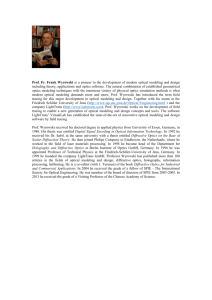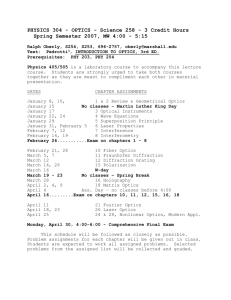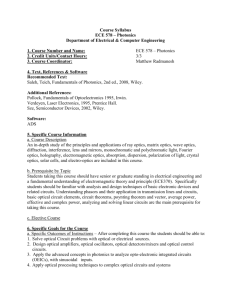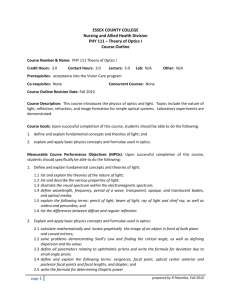The Optical Society of India
advertisement
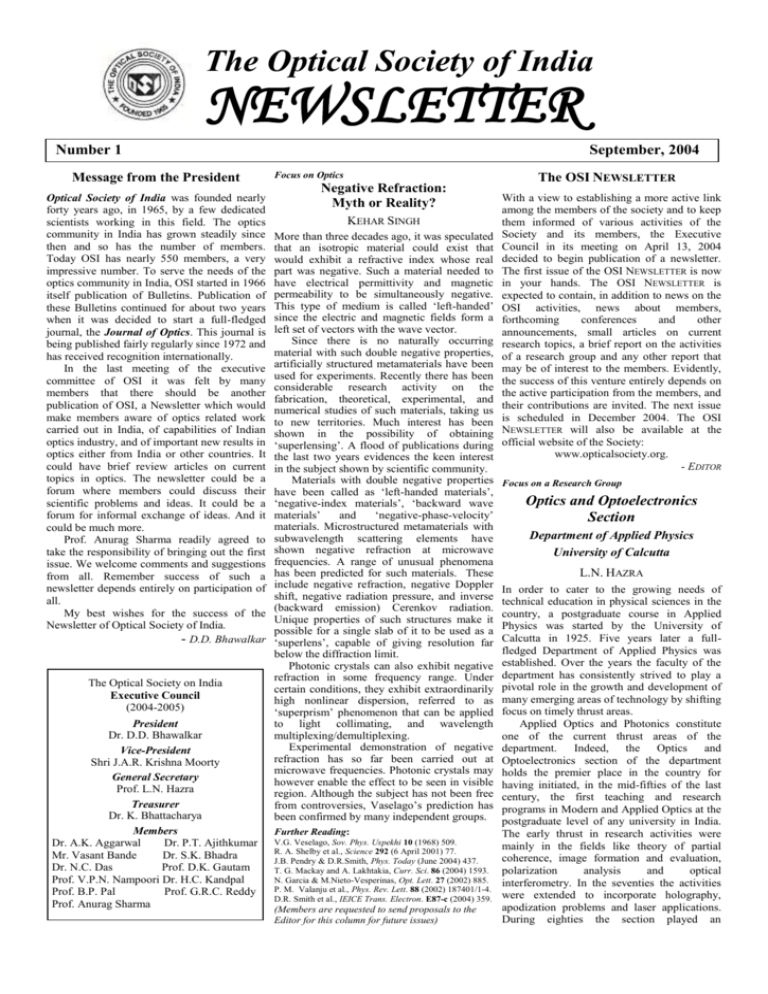
The Optical Society of India NEWSLETTER Number 1 Message from the President Optical Society of India was founded nearly forty years ago, in 1965, by a few dedicated scientists working in this field. The optics community in India has grown steadily since then and so has the number of members. Today OSI has nearly 550 members, a very impressive number. To serve the needs of the optics community in India, OSI started in 1966 itself publication of Bulletins. Publication of these Bulletins continued for about two years when it was decided to start a full-fledged journal, the Journal of Optics. This journal is being published fairly regularly since 1972 and has received recognition internationally. In the last meeting of the executive committee of OSI it was felt by many members that there should be another publication of OSI, a Newsletter which would make members aware of optics related work carried out in India, of capabilities of Indian optics industry, and of important new results in optics either from India or other countries. It could have brief review articles on current topics in optics. The newsletter could be a forum where members could discuss their scientific problems and ideas. It could be a forum for informal exchange of ideas. And it could be much more. Prof. Anurag Sharma readily agreed to take the responsibility of bringing out the first issue. We welcome comments and suggestions from all. Remember success of such a newsletter depends entirely on participation of all. My best wishes for the success of the Newsletter of Optical Society of India. - D.D. Bhawalkar The Optical Society on India Executive Council (2004-2005) President Dr. D.D. Bhawalkar Vice-President Shri J.A.R. Krishna Moorty General Secretary Prof. L.N. Hazra Treasurer Dr. K. Bhattacharya Members Dr. A.K. Aggarwal Dr. P.T. Ajithkumar Mr. Vasant Bande Dr. S.K. Bhadra Dr. N.C. Das Prof. D.K. Gautam Prof. V.P.N. Nampoori Dr. H.C. Kandpal Prof. B.P. Pal Prof. G.R.C. Reddy Prof. Anurag Sharma September, 2004 Focus on Optics Negative Refraction: Myth or Reality? KEHAR SINGH More than three decades ago, it was speculated that an isotropic material could exist that would exhibit a refractive index whose real part was negative. Such a material needed to have electrical permittivity and magnetic permeability to be simultaneously negative. This type of medium is called ‘left-handed’ since the electric and magnetic fields form a left set of vectors with the wave vector. Since there is no naturally occurring material with such double negative properties, artificially structured metamaterials have been used for experiments. Recently there has been considerable research activity on the fabrication, theoretical, experimental, and numerical studies of such materials, taking us to new territories. Much interest has been shown in the possibility of obtaining ‘superlensing’. A flood of publications during the last two years evidences the keen interest in the subject shown by scientific community. Materials with double negative properties have been called as ‘left-handed materials’, ‘negative-index materials’, ‘backward wave materials’ and ‘negative-phase-velocity’ materials. Microstructured metamaterials with subwavelength scattering elements have shown negative refraction at microwave frequencies. A range of unusual phenomena has been predicted for such materials. These include negative refraction, negative Doppler shift, negative radiation pressure, and inverse (backward emission) Cerenkov radiation. Unique properties of such structures make it possible for a single slab of it to be used as a ‘superlens’, capable of giving resolution far below the diffraction limit. Photonic crystals can also exhibit negative refraction in some frequency range. Under certain conditions, they exhibit extraordinarily high nonlinear dispersion, referred to as ‘superprism’ phenomenon that can be applied to light collimating, and wavelength multiplexing/demultiplexing. Experimental demonstration of negative refraction has so far been carried out at microwave frequencies. Photonic crystals may however enable the effect to be seen in visible region. Although the subject has not been free from controversies, Vaselago’s prediction has been confirmed by many independent groups. Further Reading: V.G. Veselago, Sov. Phys. Uspekhi 10 (1968) 509. R. A. Shelby et al., Science 292 (6 April 2001) 77. J.B. Pendry & D.R.Smith, Phys. Today (June 2004) 437. T. G. Mackay and A. Lakhtakia, Curr. Sci. 86 (2004) 1593. N. Garcia & M.Nieto-Vesperinas, Opt. Lett. 27 (2002) 885. P. M. Valanju et al., Phys. Rev. Lett. 88 (2002) 187401/1-4. D.R. Smith et al., IEICE Trans. Electron. E87-c (2004) 359. (Members are requested to send proposals to the Editor for this column for future issues) The OSI NEWSLETTER With a view to establishing a more active link among the members of the society and to keep them informed of various activities of the Society and its members, the Executive Council in its meeting on April 13, 2004 decided to begin publication of a newsletter. The first issue of the OSI NEWSLETTER is now in your hands. The OSI NEWSLETTER is expected to contain, in addition to news on the OSI activities, news about members, forthcoming conferences and other announcements, small articles on current research topics, a brief report on the activities of a research group and any other report that may be of interest to the members. Evidently, the success of this venture entirely depends on the active participation from the members, and their contributions are invited. The next issue is scheduled in December 2004. The OSI NEWSLETTER will also be available at the official website of the Society: www.opticalsociety.org. - EDITOR Focus on a Research Group Optics and Optoelectronics Section Department of Applied Physics University of Calcutta L.N. HAZRA In order to cater to the growing needs of technical education in physical sciences in the country, a postgraduate course in Applied Physics was started by the University of Calcutta in 1925. Five years later a fullfledged Department of Applied Physics was established. Over the years the faculty of the department has consistently strived to play a pivotal role in the growth and development of many emerging areas of technology by shifting focus on timely thrust areas. Applied Optics and Photonics constitute one of the current thrust areas of the department. Indeed, the Optics and Optoelectronics section of the department holds the premier place in the country for having initiated, in the mid-fifties of the last century, the first teaching and research programs in Modern and Applied Optics at the postgraduate level of any university in India. The early thrust in research activities were mainly in the fields like theory of partial coherence, image formation and evaluation, polarization analysis and optical interferometry. In the seventies the activities were extended to incorporate holography, apodization problems and laser applications. During eighties the section played an important role in promoting photonics Forthcoming Events activities in the country by laying particular PHOTONICS-2004 emphasis on the development of manpower in 7th International Conference on the area of fibre optics and photonics under the fibre system and application promotion Optoelectronics, Fiber Optic and Photonics December 9-11, 2004, Kochi program of the Department of Electronics. Contact: Convener, PHOTONICS-2004, The areas of current research interest International School of Photonics, include optical and photonic systems design Cochin University of Science and Technology, and development, optics for computing, Kochi - 682 022 diffractive and binary optics, laser beam Email: convener@photonics2004.com shaping, adaptive optics, vector wave imagery URL: http://www.photonics2004.com and image processing, global optimisation of Seminar on Recent Developments in lens design, optical metrology, optical Optics and Photonics artificial intelligence, ring laser gyro and December 20-21, 2004, New Delhi gradient index optics. Several sponsored Contact: Prof. Anurag Sharma, Physics projects are undertaken in these areas. Department, IIT Delhi, New Delhi – 110016 Indigenously developed in-house lens design Email: asharma@physics.iitd.ac.in software is available to tackle optics design National Laser Symposium (NLS-4) problems. January 10-13, 2005 The department conducts a 3-Yr B.Tech. BARC, Mumbai and a 2-Yr M.Tech. course in ‘Optics and Contact: Dr. B.M. Suri, B-204A, Mod. Labs, Optoelectronics’ (both approved by AICTE) Laser & Plasma Technology Division, BARC, along with Ph.D. programs in Applied Optics Mumbai - 400 085 and Photonics. Providing technical know-how Email: nls-4@barc.ernet.in and consultancy to industry, and imparting Phone: 022-25595017, Fax: 022-25505151 training for updating knowledge base of XXX OSI Symposium on Optics and sponsored personnel from industry and R&D Optoelectronics (SOOP-05) centres of the country constitute a major January 19-21, 2005, New Delhi activity of the optics and optoelectronics Abstract Deadline: October 15, 2004 section of the department. In recognition of Contact: Dr. H.C. Kandpal, Convener, activities of the department the University SOOP-05, National Physical laboratory, Dr. K.S. Grants Commission has recently sanctioned a Krishnan Marg, New Delhi – 110012, Email: SAP program in Photonics in the department. hckandpal@mail.nplindia.ernet.in For promotion of optics activities in the Winter College on Optics and Photonics in country, the optics faculty of the department Nanoscience and Technology took a major initiative in 1965 towards the February 7-18, 2005, Trieste, Italy formation of the Optical Society of India, and Abdus Salam International Centre for Theoretical the department is providing the basic Physics, Trieste, Italy infrastructure for sustenance of the society Contact: smr1643@ictp.trieste.it since its inception. URL: http://www.ictp.trieste.it (Members are requested to send items to the Editor for this column for future issues) International Topical Conference in Applied Photonics Member News Core theme: Superresolution and Photonics Prof. R.S. Sirohi (Director, IIT Delhi), former President of the OSI, has been conferred Padma Shri in 2004. He was earlier awarded the Hari Om Ashram Trust Award entitled Sir C.V. Raman Award: Physical Sciences for the year 2002. Prof. A.K. Ghatak (Emeritus Fellow, IIT Delhi), past President of the OSI, was awarded Esther Hoffman Beller Award (2003) by the Optical Society of America. He was also presented the MM Chugani (2003) Award by the Indian Physics Association. Prof. K. Singh (Emeritus Fellow, IIT Delhi), former President of the OSI, has been elected Fellow of the Indian National Academy of Engineering (2004). Prof. Anurag Sharma (Professor, IIT Delhi) has been elected Fellow of the Optical Society of America (2004) and Fellow of the Indian National Science Academy (2004). Dr. N.K. Mohan (Senior Scientific Officer-I, IIT Madras) has been elected Fellow of the SPIE (2003). (Members are requested to send items to the Editor for column for future issues) 15-16 February 2005, Kolkata Contact: Prof. L.N. Hazra, Department of Applied Physics, University of Calcutta, 92 A.P.C. Road, Kolkata - 700 009 Phone: (033) 23522411 Email: superresolution@rediffmail.com ICOL-2005 International Conference on Optics and Optoelectronics (XXXI OSI Symposium) December 12-15, 2005, Dehradun Contact: Dr. Ashok Kaul, Convener, ICOL-2005, IRDE, Dehradun – 248 008 Email: convener@icol2005.com URL: http://www.icol2005.com (Members are requested to send items to the Editor for column for future issues) Optics Directory of India The Executive Committee of the OSI decided in its meeting on 16.9.2003 that a directory of optics activity in India should be compiled and the responsibility of this work was given to the undersigned. For this purpose all the scientists, researchers, engineers, developers and industrialists involved in any area of optics are requested to send the information for inclusion in the Directory. The format for sending the information is as follows: A. Groups/Industries 1. 2. 3. 4. 5. 6. 7. 8. 9. 10. Name of the Group/Unit Address Contact person: telephone, fax, email Other permanent members of the Group (names) Area of Activity (include classification, see below) Major Contributions (not more than 200 words) Up to 10 notable publications, patents Major recognitions, awards, prizes, etc. Educational/Developmental Activities (description limited to 100 words) Major products, in case of Industry (description limited to 100 words) B. Individuals 1. Name 2. Present Position, Address, telephone, fax, email 3. Area of Activity (include classification, see below) 4. Major Contributions (not more than 100 words) 5. Up to 5 notable publications/patents/ books/products 6. Major recognitions, awards, prizes, etc. The directory will have two sections: one devoted to the Groups & Industries and the other to the individuals. For classification of topics, use OSA’s OCIS available at http://www.osa.org/pubs/ocis/. The information should be sent preferably by email to asharma@physics.iitd.ac.in or by post to PROFESSOR ANURAG SHARMA, PHYSICS DEPARTMENT, INDIAN INSTITUTE OF TECHNOLOGY DELHI, NEW DELHI-110 016. The support and inputs are required from all those engaged in optics activity to make this effort successful and all the contributions would be invaluable. This information may be brought to the notice of those who may not receive it otherwise. - Anurag Sharma Suggestions & Contributions A regular publication this OSI NEWSLETTER can be sustained only through active participation of the members and we seek suggestions to improve its contents and presentation. We also seek contributions from members to various columns of the OSI NEWSLETTER. In additions to the columns appearing in this issue, the future issues will also have columns on feedback from readers, reports on events such as conferences, workshops, seminars, interesting anecdotes/incidents involving optics or members and any other information that could be useful or interesting to the members. Contributions and proposals may please be sent to the editor. The next issue is scheduled for December, 2004. Members who want to receive the future issues of the OSI NEWSLETTER by email (in the PDF format) may send their email addresses to the editor. Edited by Professor Anurag Sharma, Physics Department, Indian Institute of Technology Delhi, New Delhi – 110016 (Email:asharma@physics.iitd.ac.in) Published by The Optical Society of India, Department of Applied Physics, Calcutta University, 92, Acharya Prafulla Chandra Road, Kolkata 700009

